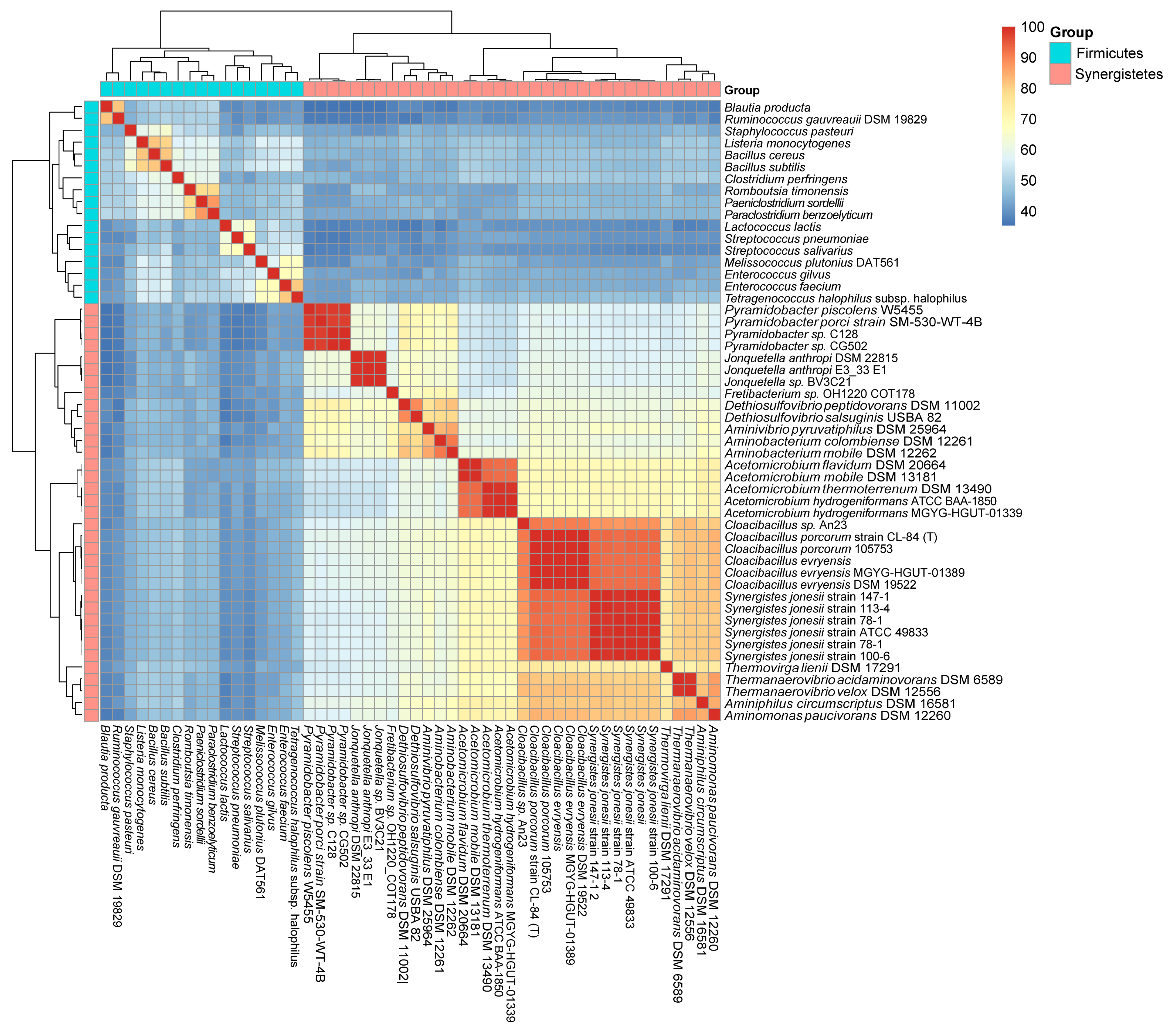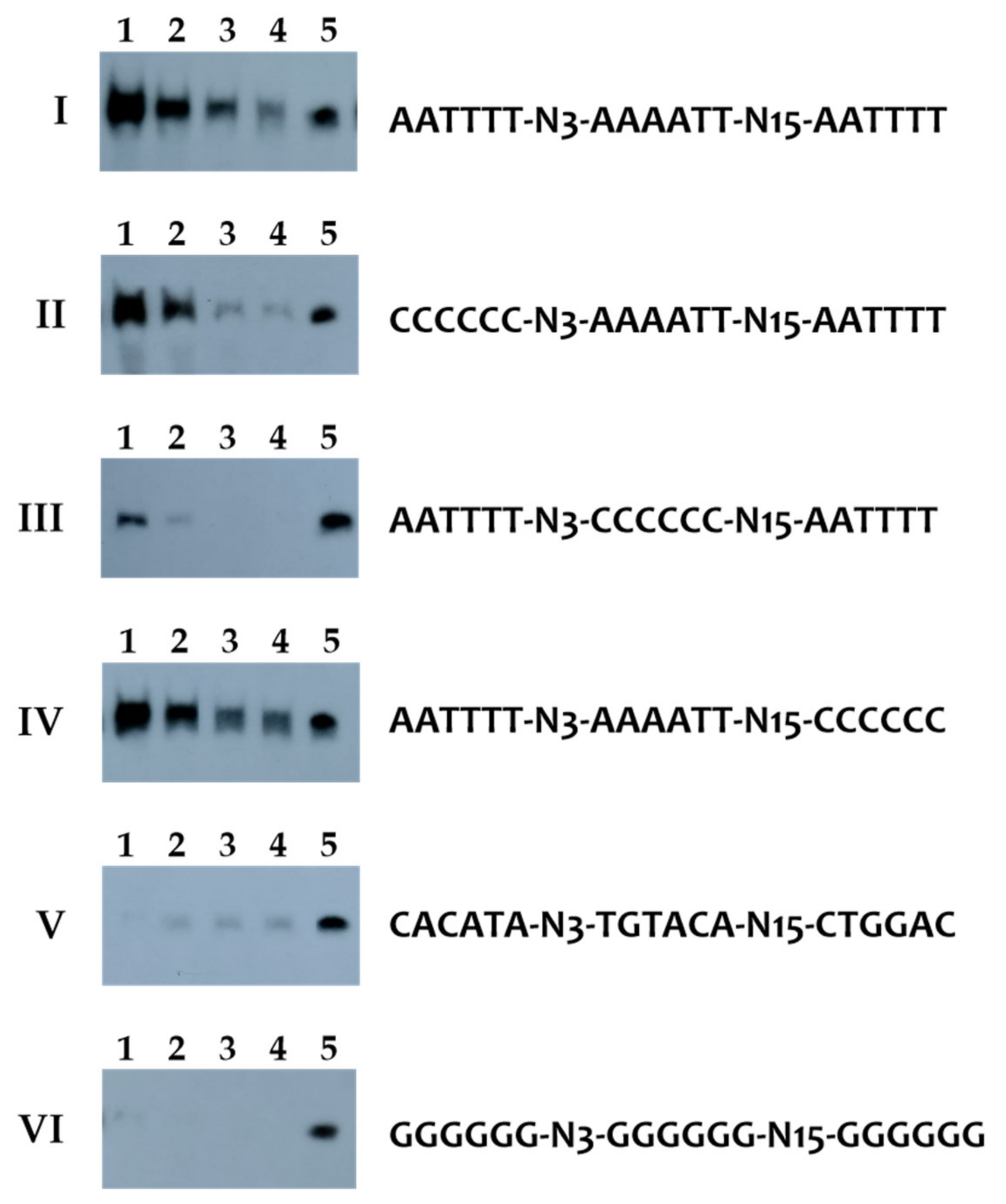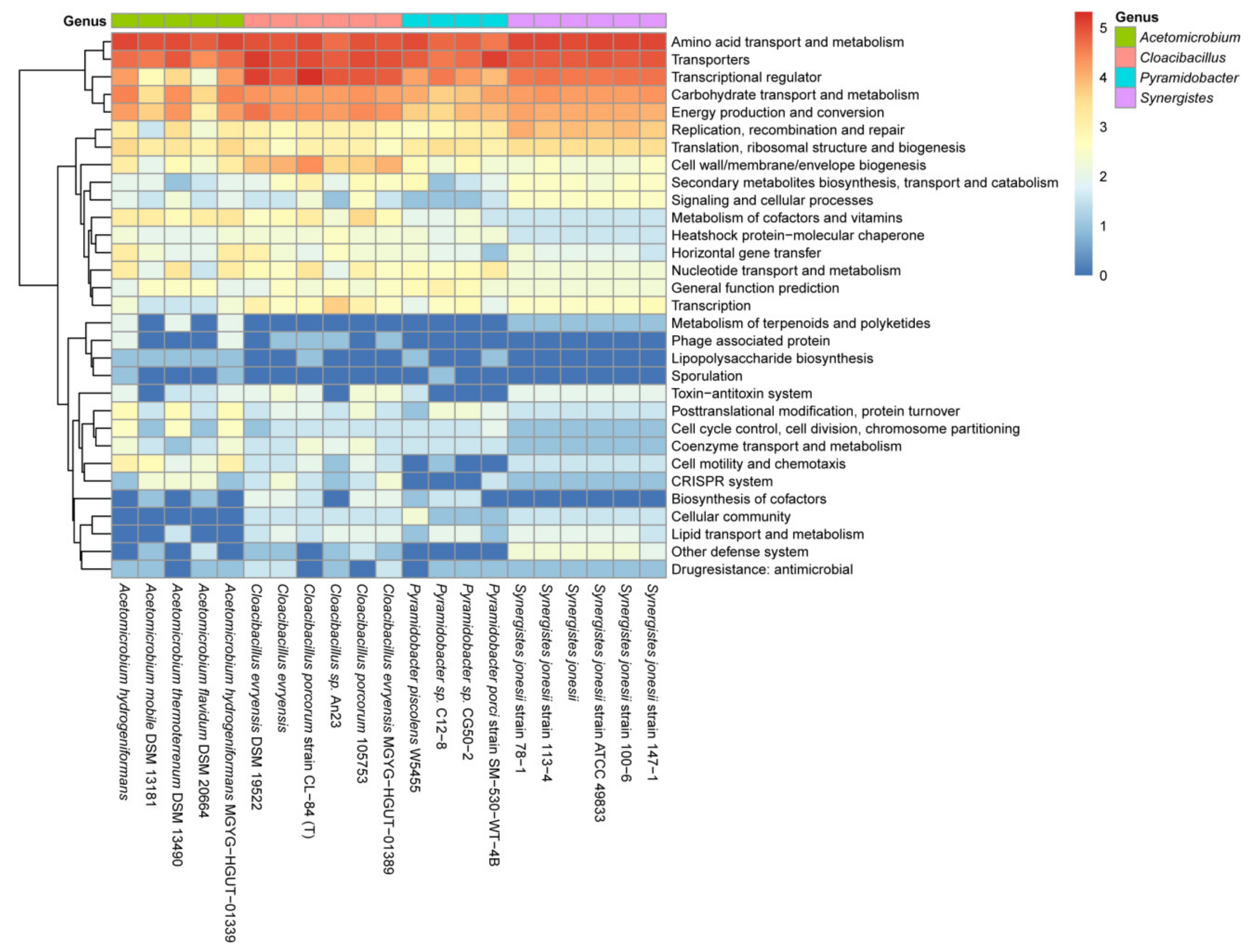Identification of a Putative CodY Regulon in the Gram-Negative Phylum Synergistetes
Abstract
:1. Introduction
2. Results
2.1. Identification and Characterization of CodY-like Proteins in the Phylum Synergistetes
2.2. The Origin of the CodY-like Protein of the Phylum Synergistetes
2.3. Analysis of the GAF-wHTH Domain
2.4. The Binding Consensus of the CodY-like Protein
2.5. The CodY-like Protein of Cloacibacillus Evryensis DSM19522 Could Interact with Both the Canonical CodY Box and an AAAATT-N15-AATTTT Palindromic Sequence
2.6. Identification and Functional Prediction of the CodY-like Regulon in the Phylum Synergistetes
3. Discussion
4. Materials and Methods
4.1. Bacterial Genome and Metagenome Database
4.2. Identification of CodY Homologous Proteins
4.3. Phylogenetic Analysis of 16S rRNA and the CodY-like/CodY Proteins from Synergistetes and Other Phyla
4.4. Purification of the Recombinant CodY-like Protein
4.5. DAPA
4.6. Binding Site Analysis and Target Gene Prediction
4.7. Functional Enrichment of the Identified Target Genes Regulated by the CodY-like Protein
Supplementary Materials
Author Contributions
Funding
Institutional Review Board Statement
Informed Consent Statement
Acknowledgments
Conflicts of Interest
References
- Jumas-Bilak, E.; Roudiere, L.; Marchandin, H. Description of ‘Synergistetes’ phyl. nov. and emended description of the phylum ‘Deferribacteres’ and of the family Syntrophomonadaceae, phylum ‘Firmicutes’. Int. J. Syst. Evol. Microbiol. 2009, 59, 1028–1035. [Google Scholar] [CrossRef] [Green Version]
- Bhandari, V.; Gupta, R.S. Molecular signatures for the phylum Synergistetes and some of its subclades. Antonie Van Leeuwenhoek 2012, 102, 517–540. [Google Scholar] [CrossRef] [PubMed]
- Maune, M.W.; Tanner, R.S. Description of Anaerobaculum hydrogeniformans sp. nov., an anaerobe that produces hydrogen from glucose, and emended description of the genus Anaerobaculum. Int. J. Syst. Evol. Microbiol. 2012, 62, 832–838. [Google Scholar] [CrossRef] [PubMed] [Green Version]
- Dahle, H.; Birkeland, N.K. Thermovirga lienii gen. nov., sp. nov., a novel moderately thermophilic, anaerobic, amino-acid-degrading bacterium isolated from a North Sea oil well. Int. J. Syst. Evol. Microbiol. 2006, 56, 1539–1545. [Google Scholar] [CrossRef] [Green Version]
- Allison, M.J.; Mayberry, W.R.; McSweeney, C.S.; Stahl, D.A. Synergistes jonesii, gen. nov., sp.nov.: A rumen bacterium that degrades toxic pyridinediols. Syst. Appl. Microbiol. 1992, 15, 522–529. [Google Scholar] [CrossRef]
- Honda, T.; Fujita, T.; Tonouchi, A. Aminivibrio pyruvatiphilus gen. nov., sp. nov., an anaerobic, amino-acid-degrading bacterium from soil of a Japanese rice field. Int. J. Syst. Evol. Microbiol. 2013, 63, 3679–3686. [Google Scholar] [CrossRef]
- Jumas-Bilak, E.; Bouvet, P.; Allen-Vercoe, E.; Aujoulat, F.; Lawson, P.A.; Jean-Pierre, H.; Marchandin, H. Rarimicrobium hominis gen. nov., sp. nov., representing the fifth genus in the phylum Synergistetes that includes human clinical isolates. Int. J. Syst. Evol. Microbiol. 2015, 65, 3965–3970. [Google Scholar] [CrossRef]
- Ndongo, S.; Dubourg, G.; Fournier, P.E.; Raoult, D. Pacaella massiliensis gen. nov., sp. nov., a new bacterial species isolated from the human gut. New Microbes New Infect. 2017, 16, 32–33. [Google Scholar] [CrossRef]
- Qiu, Y.L.; Hanada, S.; Kamagata, Y.; Guo, R.B.; Sekiguchi, Y. Lactivibrio alcoholicus gen. nov., sp. nov., an anaerobic, mesophilic, lactate-, alcohol-, carbohydrate- and amino-acid-degrading bacterium in the phylum Synergistetes. Int. J. Syst. Evol. Microbiol. 2014, 64, 2137–2145. [Google Scholar] [CrossRef]
- Vartoukian, S.R.; Downes, J.; Palmer, R.M.; Wade, W.G. Fretibacterium fastidiosum gen. nov., sp. nov., isolated from the human oral cavity. Int. J. Syst. Evol. Microbiol. 2013, 63, 458–463. [Google Scholar] [CrossRef] [PubMed]
- McCracken, B.A.; Nathalia Garcia, M. Phylum Synergistetes in the oral cavity: A possible contributor to periodontal disease. Anaerobe 2021, 68, 102250. [Google Scholar] [CrossRef] [PubMed]
- Wade, W.G. The oral microbiome in health and disease. Pharmacol. Res. 2013, 69, 137–143. [Google Scholar] [CrossRef]
- Chovatia, M.; Sikorski, J.; Schroder, M.; Lapidus, A.; Nolan, M.; Tice, H.; Glavina Del Rio, T.; Copeland, A.; Cheng, J.F.; Lucas, S.; et al. Complete genome sequence of Thermanaerovibrio acidaminovorans type strain (Su883). Stand. Genom. Sci. 2009, 1, 254–261. [Google Scholar] [CrossRef] [PubMed] [Green Version]
- Davis, C.K.; Webb, R.I.; Sly, L.I.; Denman, S.E.; McSweeney, C.S. Isolation and survey of novel fluoroacetate-degrading bacteria belonging to the phylum Synergistetes. FEMS Microbiol. Ecol. 2012, 80, 671–684. [Google Scholar] [CrossRef] [PubMed] [Green Version]
- Schoch, C.L.; Ciufo, S.; Domrachev, M.; Hotton, C.L.; Kannan, S.; Khovanskaya, R.; Leipe, D.; McVeigh, R.; O’Neill, K.; Robbertse, B.; et al. NCBI Taxonomy: A comprehensive update on curation, resources and tools. Database 2020, 2020, baaa062. [Google Scholar] [CrossRef] [PubMed]
- Plichta, D.R.; Juncker, A.S.; Bertalan, M.; Rettedal, E.; Gautier, L.; Varela, E.; Manichanh, C.; Fouqueray, C.; Levenez, F.; Nielsen, T.; et al. Transcriptional interactions suggest niche segregation among microorganisms in the human gut. Nat. Microbiol. 2016, 1, 16152. [Google Scholar] [CrossRef]
- Hugenholtz, P.; Hooper, S.D.; Kyrpides, N.C. Focus: Synergistetes. Environ. Microbiol. 2009, 11, 1327–1329. [Google Scholar] [CrossRef]
- Slack, F.J.; Serror, P.; Joyce, E.; Sonenshein, A.L. A gene required for nutritional repression of the Bacillus subtilis dipeptide permease operon. Mol. Microbiol. 1995, 15, 689–702. [Google Scholar] [CrossRef]
- Sonenshein, A.L. Control of key metabolic intersections in Bacillus subtilis. Nat. Rev. Microbiol. 2007, 5, 917–927. [Google Scholar] [CrossRef]
- Guedon, E.; Sperandio, B.; Pons, N.; Ehrlich, S.D.; Renault, P. Overall control of nitrogen metabolism in Lactococcus lactis by CodY, and possible models for CodY regulation in Firmicutes. Microbiology 2005, 151, 3895–3909. [Google Scholar] [CrossRef] [Green Version]
- Hendriksen, W.T.; Bootsma, H.J.; Estevao, S.; Hoogenboezem, T.; de Jong, A.; de Groot, R.; Kuipers, O.P.; Hermans, P.W. CodY of Streptococcus pneumoniae: Link between nutritional gene regulation and colonization. J. Bacteriol. 2008, 190, 590–601. [Google Scholar] [CrossRef] [PubMed] [Green Version]
- Biswas, R.; Sonenshein, A.L.; Belitsky, B.R. Genome-wide identification of Listeria monocytogenes CodY-binding sites. Mol. Microbiol. 2020, 113, 841–858. [Google Scholar] [CrossRef] [PubMed]
- Stenz, L.; Francois, P.; Whiteson, K.; Wolz, C.; Linder, P.; Schrenzel, J. The CodY pleiotropic repressor controls virulence in gram-positive pathogens. FEMS Immunol. Med. Microbiol. 2011, 62, 123–139. [Google Scholar] [CrossRef] [PubMed] [Green Version]
- Han, A.R.; Kang, H.R.; Son, J.; Kwon, D.H.; Kim, S.; Lee, W.C.; Song, H.K.; Song, M.J.; Hwang, K.Y. The structure of the pleiotropic transcription regulator CodY provides insight into its GTP-sensing mechanism. Nucleic Acids Res. 2016, 44, 9483–9493. [Google Scholar] [CrossRef] [PubMed] [Green Version]
- Levdikov, V.M.; Blagova, E.; Colledge, V.L.; Lebedev, A.A.; Williamson, D.C.; Sonenshein, A.L.; Wilkinson, A.J. Structural rearrangement accompanying ligand binding in the GAF domain of CodY from Bacillus subtilis. J. Mol. Biol. 2009, 390, 1007–1018. [Google Scholar] [CrossRef] [Green Version]
- den Hengst, C.D.; van Hijum, S.A.; Geurts, J.M.; Nauta, A.; Kok, J.; Kuipers, O.P. The Lactococcus lactis CodY regulon: Identification of a conserved cis-regulatory element. J. Biol. Chem. 2005, 280, 34332–34342. [Google Scholar] [CrossRef] [Green Version]
- Belitsky, B.R.; Sonenshein, A.L. Genetic and biochemical analysis of CodY-binding sites in Bacillus subtilis. J. Bacteriol. 2008, 190, 1224–1236. [Google Scholar] [CrossRef] [Green Version]
- Joseph, P.; Ratnayake-Lecamwasam, M.; Sonenshein, A.L. A region of Bacillus subtilis CodY protein required for interaction with DNA. J. Bacteriol. 2005, 187, 4127–4139. [Google Scholar] [CrossRef] [Green Version]
- Levdikov, V.M.; Blagova, E.; Joseph, P.; Sonenshein, A.L.; Wilkinson, A.J. The structure of CodY, a GTP- and isoleucine-responsive regulator of stationary phase and virulence in Gram-positive bacteria. J. Biol. Chem. 2006, 281, 11366–11373. [Google Scholar] [CrossRef] [Green Version]
- Villapakkam, A.C.; Handke, L.D.; Belitsky, B.R.; Levdikov, V.M.; Wilkinson, A.J.; Sonenshein, A.L. Genetic and biochemical analysis of the interaction of Bacillus subtilis CodY with branched-chain amino acids. J. Bacteriol. 2009, 191, 6865–6876. [Google Scholar] [CrossRef] [Green Version]
- Kreth, J.; Chen, Z.; Ferretti, J.; Malke, H. Counteractive balancing of transcriptome expression involving CodY and CovRS in Streptococcus pyogenes. J. Bacteriol. 2011, 193, 4153–4165. [Google Scholar] [CrossRef] [PubMed] [Green Version]
- Taboada, B.; Estrada, K.; Ciria, R.; Merino, E. Operon-mapper: A web server for precise operon identification in bacterial and archaeal genomes. Bioinformatics 2018, 34, 4118–4120. [Google Scholar] [CrossRef] [PubMed]
- Bailey, T.L.; Boden, M.; Buske, F.A.; Frith, M.; Grant, C.E.; Clementi, L.; Ren, J.; Li, W.W.; Noble, W.S. MEME SUITE: Tools for motif discovery and searching. Nucleic Acids Res. 2009, 37, W202–W208. [Google Scholar] [CrossRef] [PubMed]
- Elsholz, A.K.; Michalik, S.; Zuhlke, D.; Hecker, M.; Gerth, U. CtsR, the Gram-positive master regulator of protein quality control, feels the heat. EMBO J. 2010, 29, 3621–3629. [Google Scholar] [CrossRef] [Green Version]
- Kruger, E.; Hecker, M. The first gene of the Bacillus subtilis clpC operon, ctsR, encodes a negative regulator of its own operon and other class III heat shock genes. J. Bacteriol. 1998, 180, 6681–6688. [Google Scholar] [CrossRef] [PubMed] [Green Version]
- Brinsmade, S.R. CodY, a master integrator of metabolism and virulence in Gram-positive bacteria. Curr. Genet. 2017, 63, 417–425. [Google Scholar] [CrossRef]
- Geng, J.; Huang, S.C.; Chen, Y.Y.; Chiu, C.H.; Hu, S.; Chen, Y.M. Impact of growth pH and glucose concentrations on the CodY regulatory network in Streptococcus salivarius. BMC Genom. 2018, 19, 386. [Google Scholar] [CrossRef]
- Richardson, A.R.; Somerville, G.A.; Sonenshein, A.L. Regulating the intersection of metabolism and pathogenesis in Gram-positive bacteria. Microbiol. Spectr. 2015, 3. [Google Scholar] [CrossRef] [Green Version]
- Menes, R.J.; Muxi, L. Anaerobaculum mobile sp. nov., a novel anaerobic, moderately thermophilic, peptide-fermenting bacterium that uses crotonate as an electron acceptor, and emended description of the genus Anaerobaculum. Int. J. Syst. Evol. Microbiol. 2002, 52, 157–164. [Google Scholar] [CrossRef]
- Baena, S.; Fardeau, M.L.; Ollivier, B.; Labat, M.; Thomas, P.; Garcia, J.L.; Patel, B.K. Aminomonas paucivorans gen. nov., sp. nov., a mesophilic, anaerobic, amino-acid-utilizing bacterium. Int. J. Syst. Bacteriol. 1999, 49 Pt 3, 975–982. [Google Scholar] [CrossRef] [Green Version]
- Sekiguchi, Y.; Kamagata, Y.; Nakamura, K.; Ohashi, A.; Harada, H. Syntrophothermus lipocalidus gen. nov., sp. nov., a novel thermophilic, syntrophic, fatty-acid-oxidizing anaerobe which utilizes isobutyrate. Int. J. Syst. Evol. Microbiol. 2000, 50 Pt 2, 771–779. [Google Scholar] [CrossRef] [PubMed] [Green Version]
- Diaz, C.; Baena, S.; Fardeau, M.L.; Patel, B.K.C. Aminiphilus circumscriptus gen. nov., sp. nov., an anaerobic amino-acid-degrading bacterium from an upflow anaerobic sludge reactor. Int. J. Syst. Evol. Microbiol. 2007, 57, 1914–1918. [Google Scholar] [CrossRef] [PubMed]
- Surkov, A.V.; Dubinina, G.A.; Lysenko, A.M.; Glockner, F.O.; Kuever, J. Dethiosulfovibrio russensis sp. nov., Dethosulfovibrio marinus sp. nov. and Dethosulfovibrio acidaminovorans sp. nov., novel anaerobic, thiosulfate- and sulfur-reducing bacteria isolated from ‘Thiodendron’ sulfur mats in different saline environments. Int. J. Syst. Evol. Microbiol. 2001, 51, 327–337. [Google Scholar] [CrossRef] [PubMed] [Green Version]
- Belitsky, B.R.; Sonenshein, A.L. Genome-wide identification of Bacillus subtilis CodY-binding sites at single-nucleotide resolution. Proc. Natl. Acad. Sci. USA 2013, 110, 7026–7031. [Google Scholar] [CrossRef] [Green Version]
- Majerczyk, C.D.; Dunman, P.M.; Luong, T.T.; Lee, C.Y.; Sadykov, M.R.; Somerville, G.A.; Bodi, K.; Sonenshein, A.L. Direct targets of CodY in Staphylococcus aureus. J. Bacteriol. 2010, 192, 2861–2877. [Google Scholar] [CrossRef] [Green Version]
- Hellman, L.M.; Fried, M.G. Electrophoretic mobility shift assay (EMSA) for detecting protein-nucleic acid interactions. Nat. Protoc. 2007, 2, 1849–1861. [Google Scholar] [CrossRef]
- Huang, S.C.; Burne, R.A.; Chen, Y.Y. The pH-dependent expression of the urease operon in Streptococcus salivarius is mediated by CodY. Appl. Environ. Microbiol. 2014, 80, 5386–5393. [Google Scholar] [CrossRef] [Green Version]
- Hebditch, M.; Carballo-Amador, M.A.; Charonis, S.; Curtis, R.; Warwicker, J. Protein-Sol: A web tool for predicting protein solubility from sequence. Bioinformatics 2017, 33, 3098–3100. [Google Scholar] [CrossRef] [Green Version]
- Shivers, R.P.; Sonenshein, A.L. Activation of the Bacillus subtilis global regulator CodY by direct interaction with branched-chain amino acids. Mol. Microbiol. 2004, 53, 599–611. [Google Scholar] [CrossRef]
- den Hengst, C.D.; Curley, P.; Larsen, R.; Buist, G.; Nauta, A.; van Sinderen, D.; Kuipers, O.P.; Kok, J. Probing direct interactions between CodY and the oppD promoter of Lactococcus lactis. J. Bacteriol. 2005, 187, 512–521. [Google Scholar] [CrossRef] [Green Version]
- Lemos, J.A.; Nascimento, M.M.; Lin, V.K.; Abranches, J.; Burne, R.A. Global regulation by (p)ppGpp and CodY in Streptococcus mutans. J. Bacteriol. 2008, 190, 5291–5299. [Google Scholar] [CrossRef] [Green Version]
- Kang, S.; Khan, S.; Webb, R.; Denman, S.; McSweeney, C. Characterization and survey in cattle of a rumen Pyrimadobacter sp. which degrades the plant toxin fluoroacetate. FEMS Microbiol. Ecol. 2020, 96, fiaa077. [Google Scholar] [CrossRef] [PubMed]
- Finn, R.D.; Clements, J.; Eddy, S.R. HMMER web server: Interactive sequence similarity searching. Nucleic Acids Res. 2011, 39, W29–W37. [Google Scholar] [CrossRef] [PubMed] [Green Version]
- Kumar, S.; Stecher, G.; Tamura, K. MEGA7: Molecular Evolutionary Genetics Analysis version 7.0 for bigger datasets. Mol. Biol. Evol. 2016, 33, 1870–1874. [Google Scholar] [CrossRef] [PubMed] [Green Version]
- Edgar, R.C. MUSCLE: Multiple sequence alignment with high accuracy and high throughput. Nucleic Acids Res. 2004, 32, 1792–1797. [Google Scholar] [CrossRef] [PubMed] [Green Version]
- Letunic, I.; Bork, P. Interactive Tree of Life (iTOL) v5: An online tool for phylogenetic tree display and annotation. Nucleic Acids Res. 2021, 49, W293–W296. [Google Scholar] [CrossRef] [PubMed]
- Bradford, M.M. A rapid and sensitive method for the quantitation of microgram quantities of protein utilizing the principle of protein-dye binding. Anal. Biochem. 1976, 72, 248–254. [Google Scholar] [CrossRef]
- Bailey, T.L.; Elkan, C. Fitting a mixture model by expectation maximization to discover motifs in biopolymers. Proc. Int. Conf. Intell. Syst. Mol. Biol. 1994, 2, 28–36. [Google Scholar]
- Grant, C.E.; Bailey, T.L.; Noble, W.S. FIMO: Scanning for occurrences of a given motif. Bioinformatics 2011, 27, 1017–1018. [Google Scholar] [CrossRef] [Green Version]
- Page, A.J.; Cummins, C.A.; Hunt, M.; Wong, V.K.; Reuter, S.; Holden, M.T.; Fookes, M.; Falush, D.; Keane, J.A.; Parkhill, J. Roary: Rapid large-scale prokaryote pan genome analysis. Bioinformatics 2015, 31, 3691–3693. [Google Scholar] [CrossRef]
- Huerta-Cepas, J.; Szklarczyk, D.; Heller, D.; Hernandez-Plaza, A.; Forslund, S.K.; Cook, H.; Mende, D.R.; Letunic, I.; Rattei, T.; Jensen, L.J.; et al. eggNOG 5.0: A hierarchical, functionally and phylogenetically annotated orthology resource based on 5090 organisms and 2502 viruses. Nucleic Acids Res. 2019, 47, D309–D314. [Google Scholar] [CrossRef] [PubMed] [Green Version]
- Galperin, M.Y.; Wolf, Y.I.; Makarova, K.S.; Vera Alvarez, R.; Landsman, D.; Koonin, E.V. COG database update: Focus on microbial diversity, model organisms, and widespread pathogens. Nucleic Acids Res. 2021, 49, D274–D281. [Google Scholar] [CrossRef] [PubMed]
- Kanehisa, M.; Sato, Y.; Kawashima, M.; Furumichi, M.; Tanabe, M. KEGG as a reference resource for gene and protein annotation. Nucleic Acids Res. 2016, 44, D457–D462. [Google Scholar] [CrossRef] [PubMed] [Green Version]






| Locus_Tag | RefSeq | Assembly | GC (%) | Species |
|---|---|---|---|---|
| BUQ78_RS04225 | NZ_FSQZ01000001 | GCF_900129645 | 48.29 | Acetomicrobium flavidum DSM 20664 |
| HMPREF1705_RS06035 | NZ_ACJX03000001 | GCF_000160455 | 46.53 | Acetomicrobium hydrogeniformans |
| FY315_RS06110 | NZ_CABKOO010000001 | GCF_902374045 | 46.53 | Acetomicrobium hydrogeniformans MGYG-HGUT-01339 |
| ANAMO_RS01275 | NC_018024 | GCF_000266925 | 47.94 | Acetomicrobium mobile DSM 13181 |
| BLU12_RS09355 | NZ_FNPD01000014 | GCF_900107215 | 48.46 | Acetomicrobium thermoterrenum DSM 13490 |
| K349_RS0111180 | NZ_JAFY01000007 | GCF_000526375 | 59.16 | Aminiphilus circumscriptus DSM 16581 |
| C8D99_RS00920 | NZ_SORI01000001 | GCF_000165795 | 67.58 | Aminivibrio pyruvatiphilus DSM 25964 |
| AMICO_RS07740 | NC_014011 | GCF_000025885 | 45.31 | Aminobacterium colombiense DSM 12261 |
| K360_RS0102980 | NZ_JAFZ01000001 | GCF_000526395 | 43.88 | Aminobacterium mobile DSM 12262 |
| APAU_RS04160 | NZ_CM001022 | GCF_000165795 | 67.58 | Aminomonas paucivorans DSM 12260 |
| FXY42_RS11030 | NZ_CABKQM010000008 | GCF_902374565 | 56.26 | Cloacibacillus evryensis MGYG-HGUT-01389 |
| CLOEV_RS08630 | NZ_KK073872 | GCF_000585335 | 55.95 | Cloacibacillus evryensis DSM 19522 |
| HMPREF1006_RS10935 | NZ_JH414697 | GCF_000238615 | 56.26 | Cloacibacillus evryensis |
| BED41_RS09070 | NZ_CP016757 | GCF_001701045 | 54.84 | Cloacibacillus porcorum strain CL-84 (T) |
| HF883_RS06600 | NZ_JABAGT010000007 | GCF_012844265 | 56.42 | Cloacibacillus porcorum 105753 |
| B5F39_RS01840 | NZ_NFJQ01000002 | GCF_002159945 | 55.63 | Cloacibacillus sp. An23 |
| DPEP_RS01550 | NZ_ABTR02000001 | GCF_000172975 | 54.41 | Dethiosulfovibrio peptidovorans DSM 11002 |
| B9Y55_RS09045 | NZ_FXBB01000024 | GCF_900177735 | 55.24 | Dethiosulfovibrio salsuginis USBA 82 |
| EII26_RS10880 | NZ_RQYL01000028 | GCF_003860125 | 62.36 | Fretibacterium sp. OH1220_COT-178 |
| JONANDRAFT_RS04180 | NZ_CM001376 | GCF_000237805 | 59.50 | Jonquetella anthropic DSM 22815 |
| GCWU000246_RS04765 | NZ_GG697147 | GCF_000161995 | 59.09 | Jonquetella anthropic E3_33 E1 |
| HMPREF1249_RS06160 | NZ_AWWC01000024 | GCF_000468895 | 59.31 | Jonquetella sp. BV3C21 |
| HMPREF7215_RS03875 | NZ_ADFP01000047 | GCF_000177335 | 58.15 | Pyramidobacter piscolens W5455 |
| B0D78_RS09560 | NZ_MUHX01000026 | GCF_002007215 | 57.20 | Pyramidobacter sp. C12-8 |
| D7D26_RS08945 | NZ_RAWT01000042 | GCF_003612005 | 58.62 | Pyramidobacter sp. CG50-2 |
| FYJ74_RS00750 | NZ_VUNH01000001 | GCF_009695745 | 58.90 | Pyramidobacter porci strain SM-530-WT-4B |
| EH55_RS06015 | NZ_JMKI01000026 | GCF_000712295 | 55.86 | Synergistes jonesii strain 78-1 |
| JS79_RS06185 | NZ_JPZR01000022 | GCF_001757565 | 55.84 | Synergistes jonesii strain 147-1 |
| JS78_RS05700 | NZ_JPZS01000024 | GCF_001757415 | 55.84 | Synergistes jonesii strain 113-4 |
| JS77_RS05735 | NZ_JPZQ01000030 | GCF_001757495 | 55.85 | Synergistes jonesii strain 100-6 |
| JS73_RS05710 | NZ_JQEL01000027 | GCF_001757485 | 55.84 | Synergistes jonesii strain ATCC 49833 |
| JS72_RS09655 | NZ_JQEK01000046 | GCF_001757465 | 55.83 | Synergistes jonesii |
| TACI_RS06905 | NC_013522 | GCF_000024905 | 63.79 | Thermanaerovibrio acidaminovorans DSM 6589 |
| THEVEDRAFT_RS02110 | NZ_CM001377 | GCF_000237825 | 58.78 | Thermanaerovibrio velox DSM 12556 |
| TLIE_RS02745 | NC_016148 | GCF_000233775 | 47.10 | Thermovirga lienii DSM 17291 |
Publisher’s Note: MDPI stays neutral with regard to jurisdictional claims in published maps and institutional affiliations. |
© 2022 by the authors. Licensee MDPI, Basel, Switzerland. This article is an open access article distributed under the terms and conditions of the Creative Commons Attribution (CC BY) license (https://creativecommons.org/licenses/by/4.0/).
Share and Cite
Geng, J.; Luo, S.; Shieh, H.-R.; Wang, H.-Y.; Hu, S.; Chen, Y.-Y.M. Identification of a Putative CodY Regulon in the Gram-Negative Phylum Synergistetes. Int. J. Mol. Sci. 2022, 23, 7911. https://doi.org/10.3390/ijms23147911
Geng J, Luo S, Shieh H-R, Wang H-Y, Hu S, Chen Y-YM. Identification of a Putative CodY Regulon in the Gram-Negative Phylum Synergistetes. International Journal of Molecular Sciences. 2022; 23(14):7911. https://doi.org/10.3390/ijms23147911
Chicago/Turabian StyleGeng, Jianing, Sainan Luo, Hui-Ru Shieh, Hsing-Yi Wang, Songnian Hu, and Yi-Ywan M. Chen. 2022. "Identification of a Putative CodY Regulon in the Gram-Negative Phylum Synergistetes" International Journal of Molecular Sciences 23, no. 14: 7911. https://doi.org/10.3390/ijms23147911






